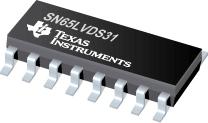●The SN55LVDS31, SN65LVDS31, SN65LVDS3487, and SN65LVDS9638 devices are differential line drivers that implement the electrical characteristics of low-voltage differential signaling (LVDS). This signaling technique lowers the output voltage levels of 5-V differential standard levels (such as TIA/EIA-422B) to reduce the power, increase the switching speeds, and allow operation with a 3.3-V supply rail. Any of the four current-mode drivers will deliver a minimum differential output voltage magnitude of 247 mV into a 100-Ω load when enabled.
●The intended application of these devices and signaling technique is both point-to-point and multidrop (one driver and multiple receivers) data transmission over controlled impedance media of approximately 100 Ω. The transmission media may be printed-circuit board traces, backplanes, or cables. The ultimate rate and distance of data transfer is dependent upon the attenuation characteristics of the media and the noise coupling to the environment.
●The SN65LVDS31, SN65LVDS3487, and SN65LVDS9638 devices are characterized for operation from –40°C to 85°C. The SN55LVDS31 device is characterized for operation from –55°C to 125°C.
● Meet or Exceed the Requirements of ANSI TIA/EIA-644 Standard
● Low-Voltage Differential Signaling With Typical Output Voltage
●of 350 mV and 100-Ω Load
● Typical Output Voltage Rise and Fall Times of 500 ps (400 Mbps)
● Typical Propagation Delay Times of 1.7 ns
● Operate From a Single 3.3-V Supply
● Power Dissipation 25 mW Typical Per Driver at 200 MHz
● Driver at High-Impedance When Disabled or With VCC = 0
● Bus-Terminal ESD Protection Exceeds 8 kV
● Low-Voltage TTL (LVTTL) Logic Input Levels
● Pin Compatible With AM26LS31, MC3487, and µA9638
● Cold Sparing for Space and High-Reliability Applications Requiring
●Redundancy

 Part 3D Model
Part 3D Model
